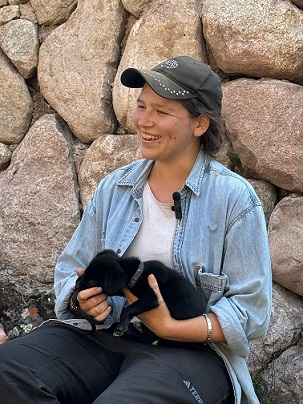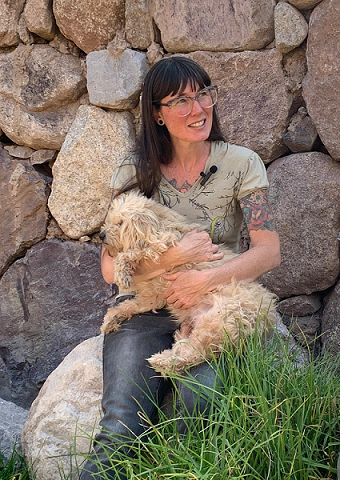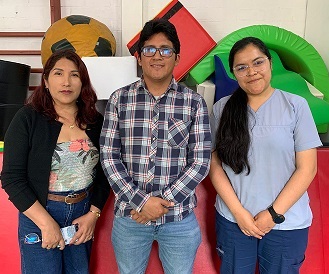“Colitas con canas” is a specialized rescue center that focuses on elderly and special needs dogs, located in Ahunamarca, just above the town of Urubamba, in Cusco, Peru. On a recent visit to the shelter by the 3Love Inc. team, we had the opportunity to speak with Emily Ellis, one of the three founders and project director, and Grainne Loftus, an Irish volunteer who has been caring for the dogs for 3 months. Both told us about the activities of this shelter and about the positive changes that this work can cause in oneself, in the dogs and in society.
Interview with Emily Ellis, Co-founder and Project Director
You first came to Peru for tourism and some time later you opened a shelter to rescue and rehabilitate animals. What motivated you to stay and live here and dedicate yourself to the care and attention of animals?
When you arrive here it in Peru, is impossible not to see the problem with the animals, specially the dogs. And I’ve always wanted to help animals. Ever since I was a small child it’s been my passion. I was able to work with someone here in the beginning who was a wild life vet and we were doing wild life rescue and rehab, which was very rewarding. But essentially the problem with the dogs was so much worse that I ended up going over to that side of the work.
In 2023, you created the “Colitas con Canas” shelter with Nikki and Corine. Why did you decide to specialize in stray dogs that are very old or have special needs?
Well, I think that anybody who’s had an elderly dog or who’s had a dog until their last days that lived a very long time, it creates a really special place in your heart for the old ones. And I’ve always been fond of them. There is a project in the United States and it’s called Susie’s Senior Dogs. And I used to follow them on Facebook and I just always loved their work so much and I’m such a big fan of what they do that it became my dream to do the same here. And being involved with adoptions, I became very aware that people are genuinely only interested in puppies. So there’s this whole demographic of dogs that don’t get adopted. And those are the ones that I wanted to focus on.
How many dogs do you currently have in the shelter? And generally, how do they get to the shelter: do you rescue them from the street or do people bring them in?
Right now, we have 31 dogs. And our dogs come to us through different ways. Sometimes some rescue groups from Cusco or different areas will contact me with a special case that they feel qualifies and they need help, they send me those cases if I can accept them. Other times, people in town will reach out to me and say: “Hey, there’s this dog. I don’t know what to do”. And sometimes I find them myself.
We have noticed that some of the dogs have special needs or disabilities. Could you mention some of the diagnoses that these dogs have?
We have 3 paraplegic dogs that can’t use their back legs or don’t have them. We have 3 dogs that are completely blind and then we have other dogs that have different physical disabilities. Dulce has two legs that are not really working that well and she’s also missing an eye, but other than that she is really OK. So, she doesn’t have a lot of special care needs as long as she is safe and cared for. And other dog that we have, Valiente, is paraplegic and lost both of his rear legs, he is a handful.
Tell us about the volunteer program. Where do the volunteers come from and what work do they do at the shelter?
We really get volunteers from all over the world. I’ve had volunteers who came from Lima. We have locals who come, not to stay here, because they live here already, but they’ll come on their days off sometimes and help out. We have a lot of people from Europe, the United States, Canada, South America, I mean, just everywhere. So, it’s really interesting, we get a lot of people from a lot of different cultures coming together here all with the same cause. While they’re here they stay a minimum of two weeks and they stay with the dogs. So, it’s very intensive. And a really big part of the work here is mostly a lot of cleaning, because we need to constantly keep the space clean, but there’s also grooming, medical care, apply medications topically or orally, walking the dogs, just being with them, cuddling them. And then sometimes you have different projects that we need to get done around here, where we all need to work together. We have days when we just need to wash the blankets and things like that. That’s mostly what the volunteers do. Sometimes we get volunteers with specialties, which is very fun. We had one volunteer who came and he was a carpenter and he knew about construction, so we definitely took advantage of that, but he was also here with the dogs, he was great with the dogs. I had a chef come through and he looked at my kitchen and he said: “Would you mind if I reorganize?” and I said “Go for it”, he made just everything better. So, the dogs are the main focus, but volunteers come with all kinds of specialties. Sometimes we get physical therapists that will work with the dogs.
In rural regions of Peru, such as the Sacred Valley, there is an overpopulation of stray dogs. How can this problem be addressed from the point of view of health and education?
Education right there I think it’s the main issue, because personally I can be here saving as many dogs as I can, but the situation on the street won’t change unless there is a massive cultural shift, and that’s what we need. In order to achieve that, what I would like to do is combine deparatization and sterilization campaigns with education, so that we’re not providing just a free service, but we’re teaching people why it’s important. It would be great to eventually get the government involved, but for right now we’ve been focusing on working directly with schools, inviting people to come and providing services in the community.
What do you think is the main reward you get from caring for these dogs?
Honestly, there’s so much in this world that we can’t control, and so much that can be upsetting when you think about it. And just to be able to take their situation and their lives and make it better, it kind of make you feel that you fixed a little part of the world. But the main reward is when you see people change, and you know that for generations there’ll be a shift, because you got through the one person, specially when they’re kids.

Interview with Grainne Loftus, Volunteer
What do you like most about the work you do at “Colitas con Canas”?
Taking care of puppies like Beans. She’s a puppy without a mother, and it’s a very hard situation for a puppy to survive, but you’ve got to see her open her eyes for the first time, open her ears for the first time. It’s very rewarding to see the progress dogs can make, it’s very rewarding to be part of that.
What would you say to others who would be interested in volunteering here? How will this experience make a change in their lives?
For one the location is amazing, it’s such a peaceful place. You get an opportunity to check out from the real world and take a break from the stress, you can hike in the mountain, you have the sound of the river behind you all the time. And then, when you do get to work with the dogs, I think there’s something healing in it. You get to help them, but in a way, they help you, when you see them make progress, when you see the anxious dogs gain confidence, it definitely does something to your soul. So, if you need a break from the real world because the world can be a little bit dark, here you get the opportunity to create some lives and save some lives, so, it’s nice.


